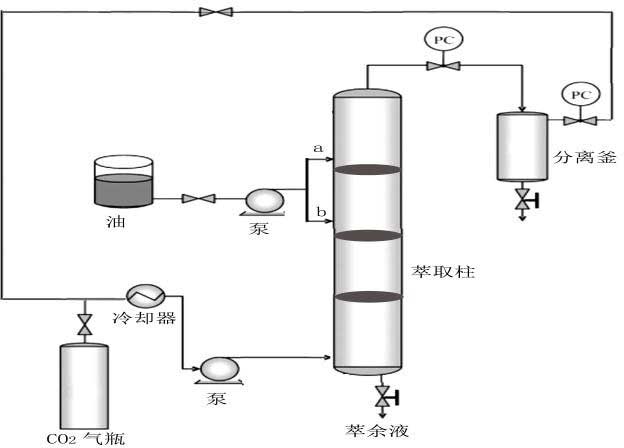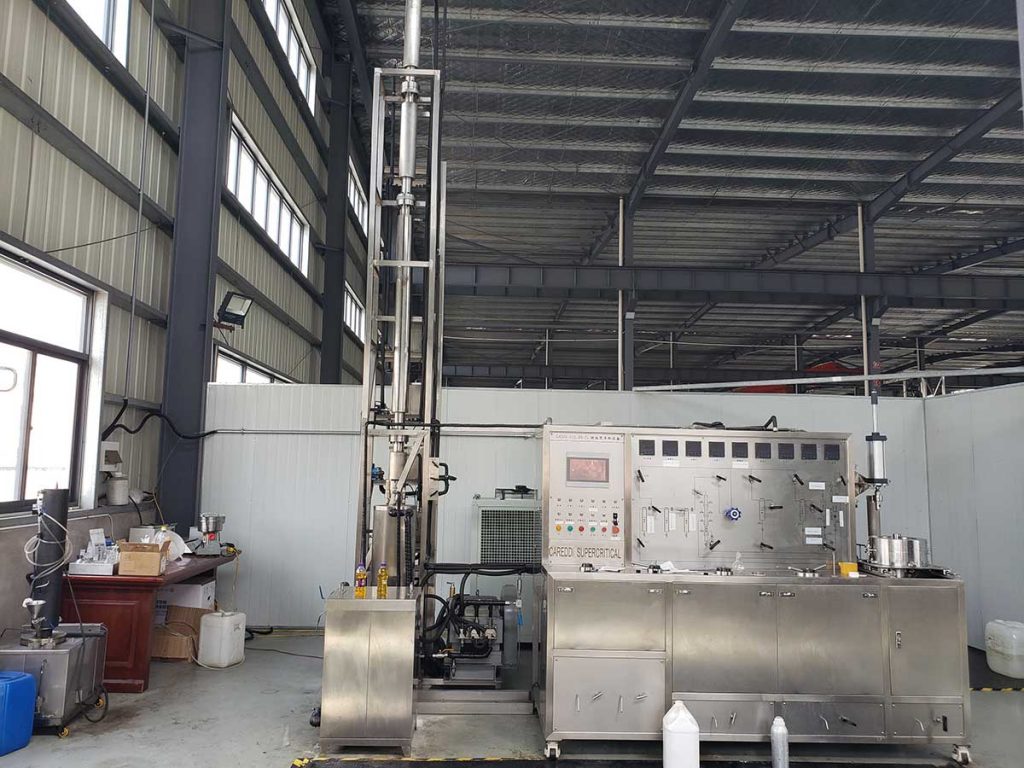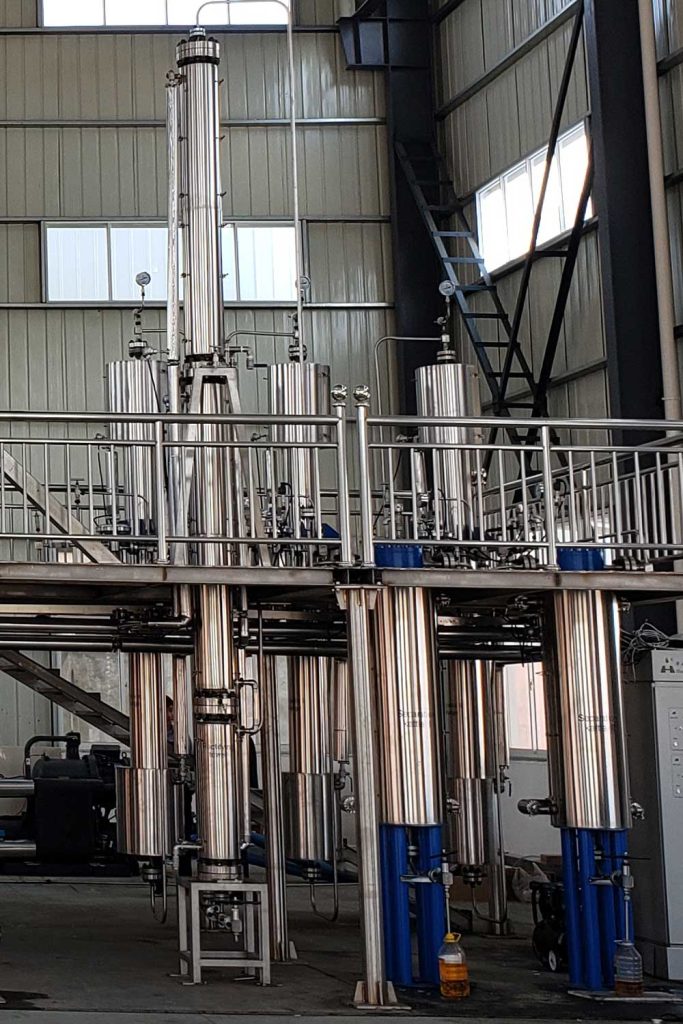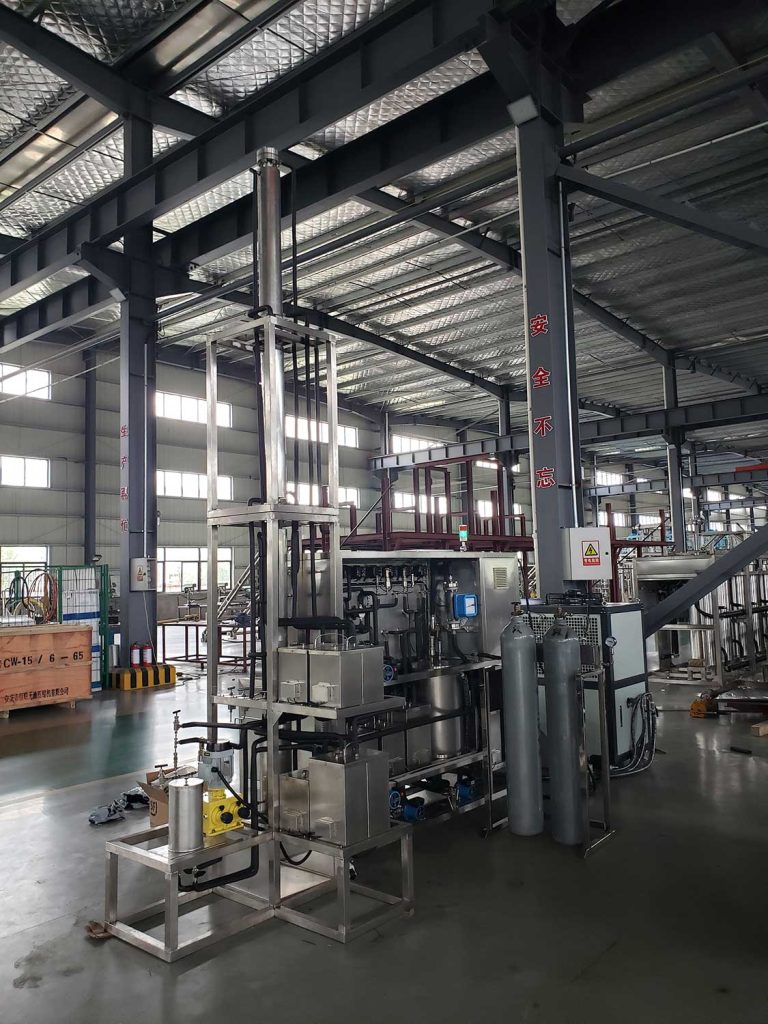Camellia oil is a high-quality edible oil that is widely used in the food and cosmetic industries. However, traditional oil processing methods, such as solvent extraction and refining, can lead to the loss of important nutrients and produce undesirable flavors and odors. Supercritical CO2 (SC-CO2) deacidification and deodorization is a sustainable and efficient method for the production of high-quality camellia oil. This article will present an overview of the principles, procedures, and advantages of SC-CO2 deacidification and deodorization of camellia oil, with a focus on its potential applications and efficiency.
Principles of SC-CO2 Deacidification and Deodorization of Camellia Oil
SC-CO2 deacidification and deodorization of camellia oil utilizes CO2 as a solvent under high pressure and temperature conditions. The process involves the use of a countercurrent system that allows for the separation and removal of free fatty acids and volatile compounds that contribute to undesirable flavors and odors. This process is sustainable and efficient and offers several advantages over traditional oil processing methods.
Procedures of SC-CO2 Deacidification and Deodorization of Camellia Oil
The SC-CO2 deacidification and deodorization of camellia oil involves several critical steps, as summarized in Table 1 below.
Summary of SC-CO2 deacidification and deodorization procedures
| Step | Procedure |
|---|---|
| 1 | Pre-treatment of camellia oil to remove any impurities and moisture |
| 2 | Loading the pre-treated oil into the extraction system |
| 3 | Introduction of SC-CO2 into the extraction system to achieve the desired pressure and temperature conditions |
| 4 | Countercurrent extraction and separation of free fatty acids and volatile compounds from the oil |
| 5 | Collection, analysis, and characterization of the deacidified and deodorized oil |
Advantages of SC-CO2 Deacidification and Deodorization of Camellia Oil
SC-CO2 deacidification and deodorization offers several advantages over traditional oil processing methods. Firstly, it is a sustainable and eco-friendly method that does not involve the use of toxic solvents or chemicals. Secondly, it is an efficient method that can reduce the processing time and costs associated with traditional methods. Thirdly, it produces high-quality oil with excellent sensory properties, such as taste, aroma, and color. Finally, it preserves the natural nutrients and antioxidants present in the oil, making it a valuable and healthy food ingredient.
Applications of SC-CO2 Deacidification and Deodorization of Camellia Oil
SC-CO2 deacidification and deodorization of camellia oil has many potential applications in the food and cosmetic industries. In the food industry, it can be used to produce high-quality cooking oils, salad dressings, and margarine. In the cosmetic industry, it can be used to produce high-quality skin and hair care products. Its sustainable and eco-friendly nature makes it an attractive option for industries that require high-quality and environmentally friendly products.
Efficiency of SC-CO2 Deacidification and Deodorization of Camellia Oil
SC-CO2 deacidification and deodorization is an efficient and sustainable method for the production of high-quality camellia oil. Its countercurrent system allows for the separation and removal of free fatty acids and volatile compounds that contribute to undesirable flavors and odors in the oil. This process produces high-quality oil with excellent sensory properties and preserves the natural nutrients and antioxidants present in the oil.
CO2 extraction process
- Feed position is at the bottom of section IV;
- Extraction pressure: 185 bar;
- Separation pressure: 50 bar;
- Four-stage temperature of the extraction column: 35 ℃, 50 ℃, 65 ℃, 80 ℃;
- CO2 flow rate:15 L/h.
Tea oil refining of CO2 extraction process
For a long time, tea oil in China is produced by two methods: mechanical pressing and solvent extraction. The crude oil is then degummed, deacidified, dehydrated, decolorized and deodorized to obtain refined tea oil .
The traditional tea oil refining process has disadvantages such as complex process, long-term high temperature heating during deodorization, which leads to the destruction of active ingredients, and alkali deacidification that easily causes environmental pollution and organic solvent residues.
Supercritical CO2 fractionating (SFF) technology has been reported for tea oil extraction.
However, the use of supercritical CO2 fractionating technology for tea oil refining has not been reported at home and abroad.
Based on the significant difference in solubility of free fatty acids and odorous substances in tea oil and triglycerides in supercritical carbon dioxide fluid.
We use supercritical carbon dioxide fluid fractionating technology to deacidify and deodorize tea oil crude oil produced by mechanical pressing or solvent extraction.
Compared with supercritical extraction used for tea oil extraction, supercritical CO2 fractionating is used for tea oil refining. It processes crude tea oil instead of tea seeds.
The processing volume is large, continuous production can be realized, and both equipment investment and operating costs are Much smaller.
The new process overcomes the shortcomings of the traditional tea oil refining process, and has the advantages of simple process, no organic solvent residues, avoiding damage and loss of active ingredients, and ensuring the natural quality of tea oil.
Experimental method
Supercritical CO2 countercurrent extraction tea oil deacidification and deodorizationThe supercritical CO2 countercurrent extraction device for tea oil is shown in Figure.

The fractionating column has an inner diameter of 34 mm and a total height of 278 cm. It consists of 4 sections, each section is 67 cm high, and the upper and lower heads are each 5 cm high.
The temperature of each section is controlled separately. When working, first heat the fractionating column and the separation kettle separately, and start the refrigerator for cooling.
When the temperature of the fractionating column, separation kettle and cooler storage tank all meet the experimental requirements, the CO2 from the CO2 cylinder is condensed by the cooler, and is fed into the extraction column and separation kettle from the bottom of the extraction column through a high-pressure pump.
When the pressure of the fractionating column and the separation kettle reaches the experimental setting value, the crude tea oil is fed into the extraction column from the middle of the extraction column through the entrainer pump, and the cyclic extraction starts. The raffinate oil and extract are discharged from the bottom of the fractionating column and the separation kettle every 15 minutes.
Get the optimization co2 extraction process
Based on the significant differences in the solubility of free fatty acids and odorous substances in tea oil and triglycerides in supercritical CO2 fluid, the solubility of triglycerides in supercritical CO2 according to the negative temperature effect stage, constant pressure and rising temperature Based on the principle that free fatty acids and odorous substances are reduced more greatly, we design an experimental program. The effects of feed position, pressure, temperature and CO2 flow rate on the deacidification and deodorization effect of tea oil were discussed.
feeding position
When the countercurrent extraction pressure is 14MPa, the four-stage temperature of the extraction column is 35℃, 50℃, 65℃ and 80℃, the pressure of the separation tank is 5MPa, the temperature of the separation tank is 40℃, and the CO2 flow rate is 15L/h, they are at the bottom of section IV. And feed at the bottom of section III.
It can be seen that the deacidification effect of the bottom feed in section IV is better than the bottom feed in section III. The reason may be that the tea oil has a longer countercurrent contact with supercritical CO2 after feeding at a, and the separation of free fatty acids and triglycerides is more complete.
pressure
As the pressure of the extraction column increases, the quality of the raffinate gradually decreases, and the quality of the extract gradually increases, while the acid value of the raffinate gradually decreases, and the acid value of the extract gradually decreases.
It can be seen that within an appropriate range, the deacidification effect is enhanced with the increase of pressure.
The reason is that the pressure increases, the density of supercritical CO2 increases, and the solubility of free fatty acids increases.
But when the pressure is too high, the difference in solubility of each component in supercritical CO2 is reduced, reducing the separation effect, and too much tea oil is lost by extraction.
Considering that the extraction pressure is 18.5MPa, the acid value of the crude tea oil after one extraction under this pressure is reduced from 3.66 to 2.60, which is a reduction of 28.96%.



temperature
Under the experimental pressure, the light components (free fatty acids) in the tea oil after feeding are dissolved in supercritical CO2, and go up with the supercritical CO2 fluid, while the heavy components (triglycerides) mainly go down.
At the same time, the light components entrained by the heavy components gradually dissolve in the supercritical CO2 fluid and move upward. As the temperature gradient of the extraction column increases step by step, the heavy components entrained by the light components gradually precipitate out, forming reflux.
That the deacidification effect under temperature gradient conditions is better than that under isothermal conditions. It shows that the increasing temperature gradient step by step is beneficial to produce stable reflux and improve separation efficiency.
flow rate
Under the conditions of countercurrent extraction pressure of 14MPa, four-stage temperature of the extraction column at 35°C, 50°C, 65°C and 80°C, separation tank pressure 5MPa, and separation tank temperature 40°C, the effect of CO2 flow rate on the deacidification effect was investigated.
When the CO2 flow rate is 15L/h, the deacidification effect is the optimization.
That the flow velocity is too large, although it accelerates the solute diffusion rate in the fluid, it causes insufficient heat and mass transfer, causes backmixing, and reduces the separation effect.
If the flow of CO2 is too high, flooding will also occur, that is, the falling camellia oil is entrained by the rising CO2 and flows directly from the top of the extraction column due to the increase in resistance, destroying the countercurrent extraction.
Optimization CO2 extraction process of tea oil
Under the conditions of the four stages of the extraction column at 35°C, 50°C, 65°C and 80°C, the separation tank pressure 5MPa, and the separation tank temperature 40°C, the effect of extraction pressure on the deacidification effect was investigated.
Under each pressure, the odor of the raffinate tea oil is less than 1/4 of the original odor, and the odor substances are concentrated in the extract, which has a significant deodorization effect.
The traditional method of deodorizing tea oil is to heat the tea oil in a deodorizing pot to 240°C for several hours, during which some functional components of the tea oil will be destroyed.
In contrast, supercritical CO2 countercurrent extraction deacidification is carried out in a low-temperature inert environment, and the functional components in tea oil will not be destroyed.
Conclusion
Through single-factor experiments, it is determined that the better tea oil deacidification and deodorization process conditions are: the feed position is at the bottom of section IV, the extraction pressure is 18.5 MPa, and the four-stage temperature of the extraction column is 35 ℃, 50 ℃, 65 ℃, and 80 ℃. The CO2 flow rate is 15 L/h.
Under these conditions, the acid value of a countercurrent extraction of tea oil was reduced from 3.66 to 2.60, and the odor was significantly reduced. In addition, the acid value and odor of tea oil can be lowered by multiple countercurrent extractions.
This research provides a new deacidification and deodorization method for tea oil refining. The method has the advantages of simple process, no organic solvent residue, avoiding damage and loss of active ingredients, and maintaining the natural quality of tea oil.
Camellia oil
Camellia oil is an oil refined from the fruit of Camellia oleifera. Because it is rich in unsaturated fatty acids, glycerides and various vitamins.
It is an ideal high-nutrition, low-calorie, high-end Health edible oil.
In recent years, the International Food and Agriculture Organization has listed tea oil as a healthy edible oil to be promoted.
The quality of Chinese camellia oil has been verified by the White House Institute of Health and the Chinese Center for Disease Control to be superior to the world-recognized olive oil and is known as the “Oriental Olive Oil.”
Conclusion
In conclusion, SC-CO2 deacidification and deodorization of camellia oil is a sustainable and efficient method for the production of high-quality edible and cosmetic oils. Its countercurrent system allows for the separation and removal of free fatty acids and volatile compounds, producing oil with excellent sensory properties and preserving natural nutrients and antioxidants. With its wide range of applications in various industries, this method is becoming increasingly important for sustainable and efficient oil production.
Advantages of SC-CO2 Deacidification and Deodorization of Camellia Oil
SC-CO2 deacidification and deodorization of camellia oil offers several advantages, as listed below:
- Sustainable and eco-friendly method that does not involve the use of toxic solvents or chemicals
- Efficient method that reduces processing time and costs associated with traditional methods
- Produces high-quality oil with excellent sensory properties, such as taste, aroma, and color
- Preserves the natural nutrients and antioxidants present in the oil, making it a healthy food ingredient
- Wide range of applications in the food and cosmetic industries
Overall, SC-CO2 deacidification and deodorization is a promising method for the sustainable and efficient production of high-quality camellia oil. With its numerous advantages and potential applications, this method is becoming increasingly important for industries that require sustainable and high-quality products. The use of tables and lists in this article has helped to present the information in a clear and concise manner, making it easier for readers to understand the principles, procedures, advantages, applications, and efficiency of SC-CO2 deacidification and deodorization of camellia oil.